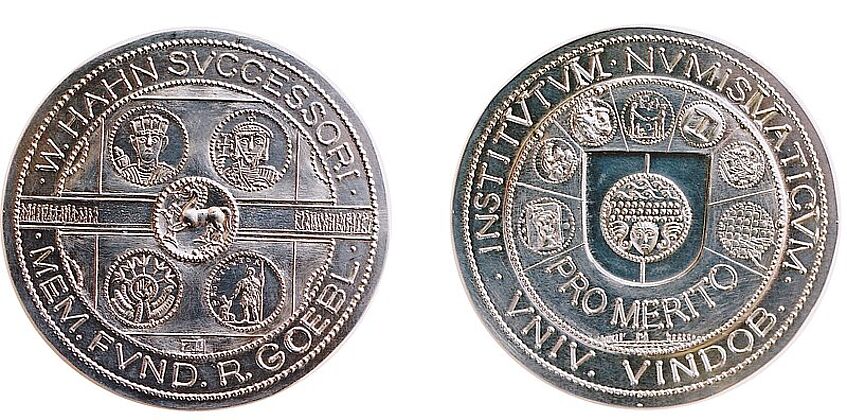Obverse
Opus number 1241:
INSTITVTVM · NVMISMATICVM · / VNIV. VINDOB. / PRO MERITO
(highlighted letters show the date in the form of a chronogram, 2010)
The striking “Frontalgesichts-Typ und Pferd” (front view type and horse) (number WNR 911, 912) – re-cut of an Eastern Noric coin – was developed for an exhibition at the Department of Numismatics in 1992. The “Frontalgesichts-Typ” (front view type) is also the motif of the Department’s emblem, which is featured in the middle of the medal on the obverse side.
The upper semicircle shows 7 small round images, Ø between 6 and 8 mm, that are in part reproductions made from images or new creations (Zobl) on slightly elevated steel surfaces: 9h – bronze ingot (money, 1982). 10h – Coining scene hammer – anvil (Zobl). 11h – lion head, Lydia (Das Fenster; Thema 165, 2004). 12h – the nature of trad¬ing (suggestion by Bannert, Platon’s nomisma). 1h – reverse of lion head, two incuse squares (can also be interpreted as an open book, collection of knowledge). 2h – money transaction, counting board (money, 1982). 3h – example raster grid, number Pi, which was certainly already very important for coin designers at the time. It could also be interpreted as a hand, representing an object that was removed, in remembrance of Professor Göbl. Lower half: award scene.
Reverse
Opus number 1242:
W. HAHN SVCCESSORI · / · MEM. FVND. R. GOEBL
At the centre, as a logical opposite to the “Frontalgesichts-Typ” (front view type): re-cut of an Eastern Noric coin with a version of a horse (double mane).
In addition to the Celtic horse, I chose the following motifs to fill the four empty circular surfaces (Ø 10 mm each) from a wide range of antique coins relating to the academic work of Dr. Göbl (Celts, Romans, Sasasians) and Dr. Hahn (Axum, Byzantium, Bavaria, Aethiopia): Dr. Hahn: Upper section 10–11h – Axum, bust in frontal view (Oesterreichische Nationalbank, 1996, fig. 12); 1–2h – Byzantium, face in frontal view (Whitting, 1973, fig. 409); both faces with different expressions in their eyes. Dr. Göbl: Lower section 4–5h – Gallienus (Die Römische Münze, 1973, fig. 488); 7–8h – hand (Göbl, Der Sasanidische Siegelkanon, pl. 6, fig. 8 a). The hand is a symbol of the great craftsmanship of the medallist of antique coins in different eras and cultures. I regard the achievements of medallists as a record of contemporary history.
The elevation of the medal base, the squared and cloud-shaped surface, is a reference to the medieval coins whose engravings were often severely deformed by striking.
Negative in steel 1:1, steel W 360, hardened at the Austrian Mint, Ø of the coin die 80 mm, Ø of the steel cut (1:1) 50 mm.
Work on both sides was documented by 20 (obverse) and 15 (reverse) trial strikes in lead.
Striking: Große Weingarten PS 200 (of 1978); 4 to 6 strikes between 60 and 70 t, 2-3 annealing steps.
Strikings (stamped-out portion): Silver A 900, Ø 54 mm, ca. 65 g weight, h = ca. 3 mm; punch A 900. Bronze, Ø 54 mm.
The coin dies for the negative of the design and the planchets for the striking (silver and bronze) were provided by the Austrian Mint, which also carried out the striking in the usual high quality.
Helmut Zobl

